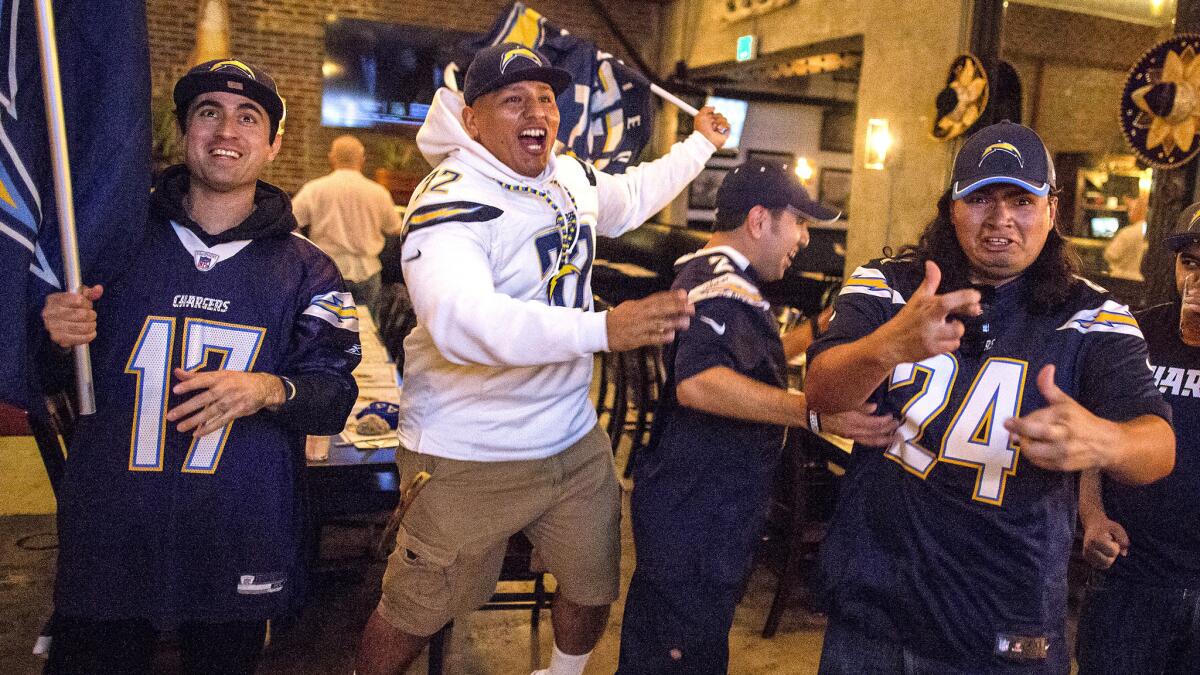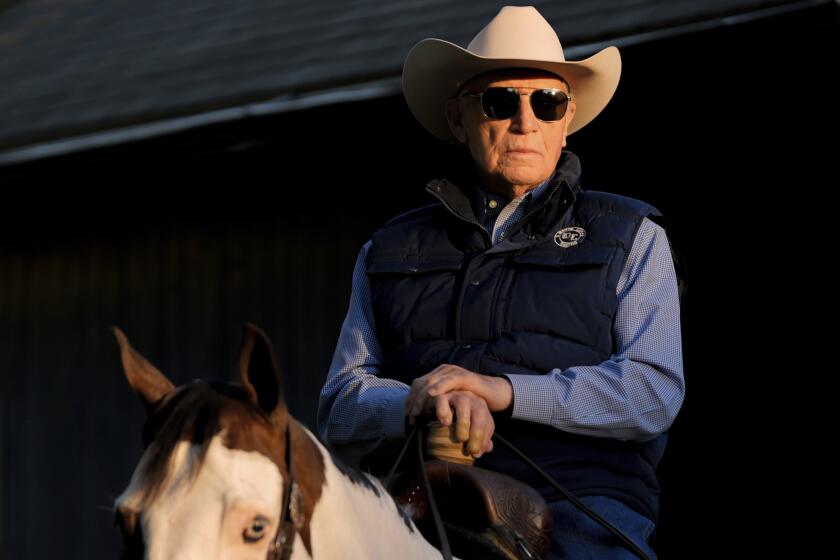Can L.A. support two NFL teams? It’s a challenge

- Share via
When Dan Reeves moved the Rams from Cleveland to Los Angeles in 1946, the owner made a prediction about his new home.
“It’s going to be the greatest professional football town in the country,” Reeves said.
Seventy-one years later, the boast about the nation’s second-largest market remains an open question.
With an early-morning announcement Thursday, the Chargers ended 56 seasons in San Diego and joined the Rams in L.A. After the NFL’s 21-year absence from the region, two teams have returned in the space of 365 days to an area already crowded with college and professional sports options.
Though the NFL has long been steadfast in its public belief that L.A. can support two teams, there is unease in private. Some in league circles believe the Chargers made a hasty decision to move. As the NFL’s television ratings plunged this season, there is also concern the addition of a second struggling team could saturate a market that’s already lost three franchises.
“L.A. has a well-earned reputation for being a community that over-supports front-runners and under-supports teams that don’t do well,” said Marc Ganis, president and founder of the Chicago-based sports consulting firm SportsCorp. “Frankly, I have meaningful doubts about L.A. supporting two teams with sellouts unless both become very successful on the field.”
Victor Matheson, a sports economist at College of the Holy Cross in Massachusetts who has studied the NFL, was blunt.
“L.A. isn’t a risky market,” he said. “But it becomes a risky market when you add a second team.”
The issue is attention, not population or money. Even for the nation’s most popular league, standing out in a sprawling, easily distracted region already loaded with professional baseball, basketball, hockey and soccer teams — in addition to USC and UCLA — isn’t a given.
Though the Rams received more than 45,000 season-ticket deposits in the first 48 hours they were available last year — and averaged 84,456 fans a game at the Coliseum — the excitement soon faded into the dreary reality of a 4-12 season and an awkward divorce from coach Jeff Fisher. Television ratings drooped and empty seats were a familiar sight at the Coliseum by season’s end.
The one thing you can never do in L.A, rapper and filmmaker Ice Cube noted in his 2010 documentary on Al Davis and the Raiders, is lose.
The Chargers, coming off a 5-11 season, face an even steeper challenge. Founded in L.A. in 1960 before decamping for San Diego the following year, they must differentiate themselves from the Rams and build a mostly new season-ticket base. The team estimates 25% of its season-ticket holders in San Diego came from Orange County and L.A., but they don’t have the same long-term history in the region as the Rams when they returned last year after 21 seasons in St. Louis.
When the Chargers’ logo flashed on the big screen at Staples Center during the Lakers-Clippers game Saturday, the crowd booed.
The Chargers didn’t immediately have a total of how many refundable $100 season-ticket deposits the team has received in the first 48 hours since the move.
“We know we’re going to have to fight our way into this market,” Chargers President Dean Spanos said. “There’s a tremendous amount of competition here. We believe we have to fight to gain the respect of the fans and season-ticket holders and people we’re doing business with. That’s for sure. We have to do that by winning on the field.”
The underdog mentality is reflected in a slogan on the team’s website detailing the relocation: “Fight for L.A.” The teams, in essence, will be competing for the same fans and many of the same big-ticket corporate sponsors as they try to carve out their share of L.A.
“The NFL is essentially making a bet that the market is too big to fail,” said Daniel Etna, a New York-based attorney who works with professional sports teams. “I’m not sure I’d want to be the guy who has to put the Thanksgiving turkey on the table by selling tickets for either of these teams.”
Added Ganis: “Teams that are successful don’t relocate. Neither of these teams has shown in the past a great ability to market. … Now we have to see if they can change their way of doing business.”
The $2.6-billion stadium the Rams and Chargers will share in Inglewood when it’s completed in 2019 — the venue includes two home locker rooms and identical suites for each owner —- will go a long way toward determining the success of the league’s return.
At the project’s groundbreaking in November, NFL Commissioner Roger Goodell called the project “transformational.”

Lindsey Thiry and Nathan Fenno discuss the Chargers’ announcement they are moving to Los Angeles.
Amy Trask, chief executive of the Raiders from 1997 to 2003, believes two teams playing in the sail-shaped stadium with a transparent roof will increase the value of naming rights, signage and other sponsorship deals at the venue.
“The story is not going to be fully written in the next year or two,” said Trask, currently an NFL analyst for CBS. “I believe we’re going to have to wait until that building is open until we draw any final or sweeping consolations.”
Rams owner Stan Kroenke is financing the stadium, the centerpiece of a 298-acre sports and entertainment complex. The Chargers will pay $1 a year as a tenant and contribute a $200-million NFL loan and the proceeds from the sale of personal seat licenses toward the construction.
About two-thirds of each team’s revenue, however, comes from the national television contracts that are split equally among the league’s 32 teams, something that’s not subject to the fluctuations of game-day revenues or local sponsorship dollars.
“That’s a tremendous insurance policy for any team that moves into a new market,” said Matheson, the Massachusetts sports economist.
Davis pursued a stadium on the same site in 1995, but the deal collapsed and the Raiders moved to Oakland. In a subsequent lawsuit against the NFL, he faulted the league’s push for a second team at the building.
“It would have been insane to have a team come in and start at the same time,” Davis testified in 2001. “ I’m not afraid of competition, but I think it was wrong.”

Chargers owners Dean and John Spanos talk about the team as it prepares to relocate to L.A.
He added that he told other owners: “What are you doing to us? I wouldn’t do it in your cities.”
Trask recalled that the concern revolved around the terms under which a second team would share the planned stadium, not the broader issue of two teams playing there.
If the under-construction stadium becomes a popular spot, she said, it’ll stand out in the L.A. market’s entertainment-driven, see-and-be-seen culture.
Long-term success in L.A., though, will need more than marketing pushes, bold slogans or even a state-of-the-art stadium. The teams need to do something that hasn’t come easily in recent years: win.
“It’ll be an attraction in and of itself,” Ganis said of the venue. “Once it’s no longer the newest, hottest toy, which could be a few years, what could happen on a long-term basis? That’s where the real question comes in.”
Twitter: @nathanfenno
More to Read
Go beyond the scoreboard
Get the latest on L.A.'s teams in the daily Sports Report newsletter.
You may occasionally receive promotional content from the Los Angeles Times.











